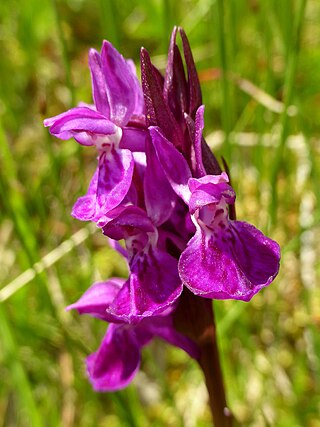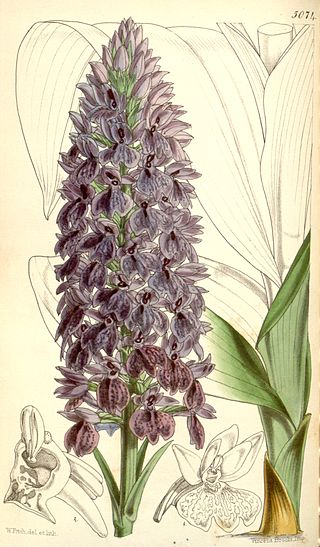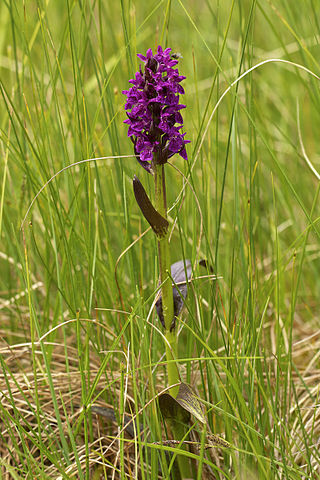
Gymnadenia conopsea, commonly known as the fragrant orchid or chalk fragrant orchid, is a herbaceous plant of the family Orchidaceae native to northern Europe.

The genus Ophrys is a large group of orchids from the alliance Orchis in the subtribe Orchidinae. They are widespread across much of Europe, North Africa, Caucasus, the Canary Islands, and the Middle East as far east as Turkmenistan.

Gymnadenia is a genus of flowering plants in the orchid family (Orchidaceae) containing 22 terrestrial species. The former genus Nigritella is now included in Gymnadenia.

Dactylorhiza is a genus of flowering plants in the orchid family Orchidaceae. Its species are commonly called marsh orchids or spotted orchids. Dactylorhiza were previously classified under Orchis, which has two round tubers.

Brassavola is a genus of 21 orchids. They were named in 1813 by the Scottish botanist Robert Brown. The name comes from the Italian nobleman and physician Antonio Musa Brassavola. This genus is abbreviated B. in trade journals.

Dactylorhiza majalis, or the broad-leaved marsh orchid, is a terrestrial Eurasian orchid.

Dactylorhiza viridis, the frog orchid, is a species of flowering plant in the orchid family Orchidaceae. It has also been treated as the only species Coeloglossum viride of the monotypic genus Coeloglossum.

Dactylorhiza praetermissa, the southern marsh orchid or leopard marsh orchid, is a commonly occurring species of European orchid.

Dactylorhiza incarnata, the early marsh-orchid, is a perennial, temperate-climate species of orchid generally found growing in wet meadows, and generally on base-rich soils, up to about 2100m asl. The species occurs widely in Europe and Asia from Portugal and Ireland east to Siberia and Xinjiang.

Dactylorhiza maculata, known as the heath spotted-orchid or moorland spotted orchid, is an herbaceous perennial plant of the family Orchidaceae. It is widespread in mountainous regions across much of Europe from Portugal and Iceland east to Russia. It is also found in Algeria, Morocco, and western Siberia.

Dactylorhiza traunsteineri, the narrow-leaved marsh orchid or Traunsteiner's dactylorhiza, is a terrestrial species of orchid native to the cooler parts of the Eastern Hemisphere. It is native to Scandinavia, the Alps, and a region extending from Germany to Western Siberia. Although said by some sources to occur in Britain and Ireland, others say that plants identified as this species are actually Dactylorhiza majalis subsp. traunsteinerioides, a view supported by genetic data.

Dactylorhiza elata, the robust marsh orchid, is a species of flowering plant in the family Orchidaceae, native to the western Mediterranean region.

Dactylorhiza foliosa, the Madeira orchid or leafy orchid, is a species of flowering plant in the family Orchidaceae, endemic to the Portuguese Island of Madeira in the eastern Atlantic Ocean. It is a tuberous herbaceous perennial growing to 60 cm (24 in) and producing spikes of intense, magenta-pink flowers in late spring.

Dactylorhiza romana, the Roman dactylorhiza, is a species of orchid. It is native to the Mediterranean Region of southern Europe and northern Africa, the range extending eastward to Iran and Turkmenistan.

Dactylorhiza sambucina, the elder-flowered orchid, is an herbaceous plant belonging to the family Orchidaceae. It is quite common and widespread throughout much of Europe from Portugal east to Finland and Ukraine. The flowers appear in spring and summer, in various colors from yellow to purple.

Puccinia sessilis is a fungal species and plant pathogen, which is also known as arum rust or ramsons rust. It commonly infects Arum maculatum and Allium ursinum causing yellow to orange circular patches on leaves. On the underside of the leaves, it produces raised orange aecia commonly covered in spores. It is common in Eurasia in the spring.

Dactylorhiza incarnata subsp. cruenta, synonym Dactylorhiza cruenta, the flecked marsh orchid, is a Palearctic orchid, native from Britain east to Siberia and south to Turkey and Xinjiang.

Orchis pallens, the pale orchid or pale-flowered orchid, is a perennial herbaceous plant belonging to the genus Orchis of the family Orchidaceae. It is found in most of Europe ranging from Spain across to the Caucasus. It blooms in spring with pale yellow flowers.

Talsi rolling hills is a nature park in the middle of Talsi Municipality. It is located in the north-western part of Vanemas pauguraine and includes the highest part, administratively belongs to Laidzes, Laucienes and Lībagu parishes. The protected area was established in 1987 to protect one of the North Kurzeme Uplands and highest part of the Elder Hill. It is most diverse areas in terms of natural conditions in the Latvia north-east, with a distinctly hilly terrain and several small but deep lakes. Scenic area. Natura 2000 territory. Many Latvia rare and protected plant and animal species. In total 24 species of flora (1) and fauna (23) are protected under EU Nature directives.























